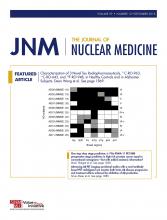Abstract
Our aim was to assess the diagnostic potential of 1-stop-shop prostate-specific membrane antigen ligand (68Ga-PSMA-11) PET/MRI compared with preoperative staging nomograms in patients with high-risk prostate cancer. Methods: A total of 102 patients underwent 68Ga-PSMA-11 PET/MRI before intended radical prostatectomy with lymph node dissection. Preoperative variables determined the probabilities for lymph node metastases (LNM), extracapsular extension (ECE), and seminal vesical involvement (SVI) using the Memorial Sloan Kettering Cancer Center (MSKCC) nomogram and Partin tables. Receiver-operating-characteristic analyses were performed to determine best discriminatory cutoffs. On a cohort basis, positivity rates of imaging and nomograms were compared with pathologic prevalence. On a patient basis, sensitivity, specificity, and area under the curves were calculated. Finally, the full concordance of each method to postoperative T and N stage was determined. Results: Seventy-three patients were finally analyzed. On a cohort basis, the MSKCC nomogram (39.7%) positivity rate was most concordant with pathologic prevalence for LNM (34.3%) compared with Partin tables (14.1%) and imaging (20.6%). Prevalence of ECE (72.6%) was best predicted by MSKCC nomograms and imaging (83.6% each), compared with Partin tables (38.4%). For prevalence of SVI (45.2%), imaging (47.9%) performed superior to MSKCC (37.6%) and Partin tables (19.3%). On a patient basis, AUCs for LNM, ECE, and SVI did not differ significantly between tests (P > 0.05). Imaging revealed a high specificity (100%) for LNM and a sensitivity (60%) comparable to the MSKCC nomogram (68%) and Partin tables (60%). For ECE, imaging revealed the highest sensitivity (94.3%) compared with the MSKCC nomogram (66%) and Partin tables (71.1%). For SVI, sensitivity and specificity of imaging and the MSKCC nomogram were comparable (81.5% and 80% vs. 87.9% and 75%). The rate of concordance to the final pTN stage was 60.3% for imaging, 52.1% for the MSKCC nomogram, and 39.7% for Partin tables. Conclusion: In our analysis, preoperative 1-stop-shop 68Ga-PSMA-11 PET/MRI performs at least equally for T and N stage prediction compared with nomograms in high-risk prostate cancer patients. Despite an improved prediction of the full final stage and the yield of additional anatomic information, the use of 68Ga-PSMA-11 PET/MRI warrants further prospective evaluation.
Footnotes
Guest Editor: Ken Herrmann, University Hospital Essen
Published online May 24, 2018.
- © 2018 by the Society of Nuclear Medicine and Molecular Imaging.







